Module 7 Intro
| Site: | MoodleHUB.ca 🍁 |
| Course: | Biology 20 SS |
| Book: | Module 7 Intro |
| Printed by: | Guest user |
| Date: | Wednesday, 24 December 2025, 6:51 AM |
Description
Created by IMSreader
Table of contents
- 1. Module 7 Intro
- 1.1. Big Picture
- 1.2. In this Module
- 1.3. Lesson 1 Intro
- 1.4. Page 2
- 1.5. Page 3
- 1.6. Lab
- 1.7. Page 5
- 1.8. Page 6
- 1.9. Page 7
- 1.10. Lesson 2 Intro
- 1.11. Page 2
- 1.12. Lab
- 1.13. Page 4
- 1.14. Page 5
- 1.15. Page 6
- 1.16. Page 7
- 1.17. Lesson 3 Intro
- 1.18. Page 2
- 1.19. Page 3
- 1.20. Page 4
- 1.21. Page 5
- 1.22. Lesson 4 Intro
- 1.23. Page 2
- 1.24. Page 3
- 1.25. Page 4
- 1.26. Page 5
- 1.27. Module Summary/Assessment
- 1.28. Module Glossary
1. Module 7 Intro
Module 7—The Digestive and Respiratory Systems
Module Introduction
The major concepts developed in this module will lead your exploration of the role of the digestive and respiratory systems in maintaining homeostasis in humans through the exchange of energy and matter with the environment. You will look at some of the physical and biochemical processes used by these systems and will see how they assist in maintaining metabolic equilibrium in the body.
You will also examine the conditions that result when the digestive and respiratory structures do not function properly and diseases may interfere with body functions. What happens to your respiratory system if your digestive system fails to work properly?
As well, you will see what technology is available to treat and prevent disorders related to the respiratory and digestive systems. Medical technology is based on the scientific knowledge connected with their treatments. This module builds on your knowledge and understanding from Science 8 and Science 10 and from Units A to C of this course. As discussed in Module 6, these systems are involuntary and are controlled by smooth muscle contractions. You will apply your knowledge of cellular respiration, energy exchange, the structure and function of animal cells, and the cycling of matter in living systems.
You already know that oxygen and carbon dioxide are exchanged when you breathe. And you know that the digestive system involves the breakdown of all that you eat. You may be familiar with the principal structures of each system, but perhaps you don’t specifically understand how each one works. As you work through this module, you will identify structures and functions through observations. You will explore technological advances that have been created to treat or prevent conditions that disrupt homeostasis within the human system.
As you work through this module, consider the following question: How do the human digestive and respiratory systems exchange matter and energy with the environment?
By the end of this module, you will have completed activities to be marked by your instructor and some activities designed to build confidence in your ability to understand, interpret, and express key course concepts. Everything should be saved in your course folder. At some point, you may need to review pieces of information for exams, project work, or discussions. For example, you will need to complete a unified response on a muscle disorder for your module project and will need to use information gathered throughout this module.
1.1. Big Picture
Module 7—The Digestive and Respiratory Systems
 Big Picture
Big Picture

© sonya etchison/shutterstock
Eating and breathing are two body functions that you are very familiar with. Each action is associated with a specific system: digestion and respiration. You know that you must eat in order to supply your body with enough nutrients to function well. You know that you breathe in order to supply oxygen to cells for cellular respiration and remove carbon dioxide as a waste from cellular respiration.
Have you considered that you are exchanging matter and allowing energy to flow through your body by eating and breathing? Your body is like a bank. Transactions are always going on. Food and oxygen enter the body and, depending on the needs of your body, are either spent immediately or stored for later.

© swimnews/shutterstock
Carbon dioxide and undigestable wastes are withdrawn from your body through a variety of processes. Sometimes systems do not work properly and the proper transactions between energy and matter cannot be made. This can result in problems or disorders of the digestive or respiratory systems.
As you work through this module, you will explore the following essential questions:
- What are the chemical characteristics of carbohydrates, lipids, and proteins and their corresponding enzymes?
- How are digestive enzyme functions controlled by the internal environment?
- How do the organs of the digestive system work together to digest carbohydrates, lipids, and proteins?
- In what way does the body facilitate the exchange of energy and matter from the digestive system?
- How do the principle structures of the respiratory system act to exchange matter and transfer thermal energy between the body and the external environment?
- How does technology provide solutions or limitations to the treatment of disorders affecting the digestive and respiratory systems?
In addition to lesson assignments and labs, there will be a module project to complete. For the module project you will have a choice of two extended responses. The purpose of an extended response is to help you take a closer look at a specific area of study. In the module project you will choose between investigating digestive enzymes through experimentation OR investigating the effects of smoking on the respiratory system.
When you are ready for more information about the project, go to the Module Summary for instructions.
1.2. In this Module
Module 7—The Digestive and Respiratory Systems
In This Module
Lesson 1—Molecules of Living System
Have you ever thought about the nature of the food you eat? Just what are you getting with that burger and fries, and how does your body use it? This lesson introduces you to the chemical nature of carbohydrates, lipids, proteins, and their enzymes (carbohydrases, lipases, and proteases).
You will also study enzyme action and some factors influencing their action (temperature, pH, substrate concentration, feedback inhibition, and competitive inhibition).
- What are the chemical characteristics of carbohydrates, lipids, and proteins and their corresponding enzymes?
- How are digestive enzyme functions controlled by the internal environment?
Lesson 2—The Digestive System
You have to eat to live, but have you thought about what happens to your food while it is being chewed and after it’s swallowed? This lesson begins with an introduction to the principal structures of the digestive system—the mouth, esophagus, stomach, sphincter, small and large intestines, liver, pancreas, and the gall bladder. You will be learning about the chemical and physical processing of food in the digestive system. You will also study how the nutrients that you need get out of the digestive system and into the circulatory system.
- How do the organs of the digestive system work together to digest carbohydrates, lipids, and proteins?
- In what way does the body facilitate the exchange of energy and matter from the digestive system?
Lesson 3—The Respiratory System
Take a deep breath, and get ready. You’re going to find out what happens when you breathe. You are going to study the principal structures of the respiratory system—nasal passages, pharynx, larynx, epiglottis, trachea, bronchi, bronchioles, alveoli, diaphragm, rib muscles, and pleural membranes. You will learn how your respiratory system uses gas exchange, how it keeps foreign material from filling your lungs, and perhaps some unexpected results of breathing.
-
How do the principle structures of the respiratory system act to exchange matter and transfer thermal energy between the body and the external environment?
Lesson 4—Science, Technology, and Society
Human systems do not always work perfectly. Homeostasis is easily disrupted by any variety of disorders that interfere with energy flow and matter exchange. Humans look to technology to help solve any problems they may experience. However, there is not always sufficient technology to provide solutions to all problems.
- How does technology provide solutions or limitations to the treatment of disorders affecting the digestive and respiratory systems?
 Module Assessment
Module Assessment
You will be graded for your work in the Lesson 1 Assignment, Lesson 2 Assignment, Lesson 3 Assignment, and Lesson 4 Assignment. In addition, you will complete a module project.
Module Project
For this module project, you will have the choice between two extended responses. The purpose of an extended response is to help you take a closer look at a specific area of study. In this case, you will choose between investigating digestive enzymes through experimentation or investigating the effects of smoking on the respiratory system.
You may choose one assignment because you feel you have a stronger grasp of the content or you may choose an assignment because you feel you would benefit from further study of that particular body system. The extended response activities allow you to further explore each body system. In the Unit Assessment you will build upon these module projects by pursuing an in-depth inquiry into the interdependence of your body systems in maintaining homeostasis.
When you have completed the lessons, go to the Module Assessment section of the Module 7 Summary for more details about your module project.
1.3. Lesson 1 Intro
Module 7—The Digestive and Respiratory Systems
Lesson 1—Molecules of Living Systems
 Get Focused
Get Focused
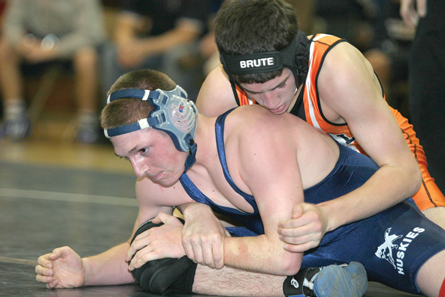
© Larry St. Pierre/Shutterstock
How are these two high-school wrestlers the same as retired World Wrestling Federation (WWF) superstar Bret “the Hitman” Hart? Hart is a member of the internationally famous Hart wrestling family from Calgary. He is recognized as one of the most intense competitors ever to leap into the professional wrestling ring. Whether performing a signature “Jumping Piledriver” or his classic finishing “Sharpshooter,” the muscles in his sculpted body bulged with every move.
Like most wrestlers, bodybuilders, and weightlifters, Hart pushed his body to its limits. His need for speed and strength required that he carefully monitor what he consumed. In a way, his diet was like balancing a bank account. What he consumed needed to match what his body was “spending” in the process of growth and repair. His diet had to contain the right balance of carbohydrates, fats and proteins, vitamins, and minerals. Each item of food was important in ensuring that the dietary needs imposed on his body, by his extreme sport, were met.
In this lesson you will learn about the important organic molecules that play a wide variety of roles in your body’s daily activities. In addition, you will learn about important proteins—called enzymes—that control the different chemical reactions taking place within your cells.
In this lesson the following questions will be examined:
- What are the chemical characteristics of carbohydrates, lipids, and proteins and their corresponding enzymes?
- How are digestive enzyme functions controlled by the internal environment?
 Module 7: Lesson 1 Assignment
Module 7: Lesson 1 Assignment
Your teacher-marked Module 7: Lesson 1 Assignment requires you to submit a response to the following:
- Lab: Enzyme-Controlled Reactions
- TR 1. Hydogen Peroxide and Catalase
You can access your Module 7: Lesson 1 Assignment. You can print off the assignment or save the download to your computer. Your answers can be saved on this document to your course folder.
1.4. Page 2
Module 7—The Digestive and Respiratory Systems
 Explore
Explore
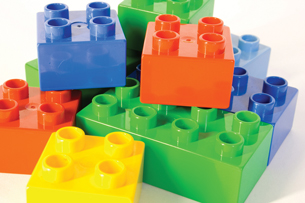
© anna karwowska/shutterstock
A macromolecule, by definition, implies "a large molecule." In biology, this refers to carbohydrates, lipids, proteins, and nucleic acids. Known as the building block of all the structures within people’s bodies, these macromolecules are used to store energy, build structures, or store genetic material. Carbohydrates can be turned into fats and stored in bodies, while muscles and organs have large amounts of proteins. Lipids comprise membranes because of their insoluble nature. Nucleic acids are the building blocks of human genetic code.
 Read
Read
Read about the macromolecules: carbohydrates, lipids, proteins, and nucleic acids on pages 207 to 211 of the textbook.
Carbohydrates, lipids, and proteins can perform three functions:
- energy (carbohydates, lipids, proteins)—Examples are starch and glycogen.
- structure (carbohydrates, lipids)—Examples are cellulose and phospholipids.
- transport (proteins)
Organic Macromolecules
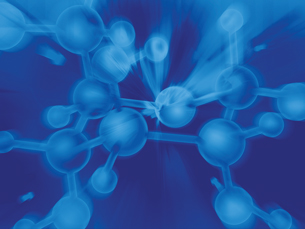
© alphaspirit/shutterstock
Organic molecules contain carbon and form the basis of most living things. It has been estimated that in nature there are millions more organic compounds than there are inorganic compounds. All four of the macromolecules that you have just read about—carbohydrates, lipids, proteins, and nucleic acids—are organic compounds. Each of these complex molecules is formed from simpler subunits in an anabolic reaction. The dehydration synthesis reaction described on page 207 of your textbook is a type of anabolic reaction.
 Watch and Listen
Watch and Listen
Watch the following animation that shows the processes of dehydration synthesis and the hydrolysis of sucrose and a protein. As you are watching, notice that for each bond formed (dehydration synthesis) another water molecule is produced. For each bond broken (hydrolysis), another water molecule is required.
anabolic: the metabolic process that builds larger molecules from smaller molecules
dehydration synthesis: an enzyme-controlled composition reaction in which compounds are formed by the removal of water
hydrolysis: the decomposition of a compound in a reaction by using water
catabolic: the metabolic process in which materials are broken down
Each macromolecule may be broken down again into its original repeating simpler subunits through catabolic reactions. In a catabolic reaction, molecules are broken down into smaller components, and energy is released. The breakdown of food in digestion is a catabolic reaction. The hydrolysis reaction described in your textbook on page 207 is an example of a type of catabolic reaction. Note that both of these reactions require enzymes to take place.
1.5. Page 3
Module 7—The Digestive and Respiratory Systems
 Watch and Listen
Watch and Listen
What’s in This Food?
Three macromolecules (carbohydrates, proteins, and lipids) that you have studied in this lesson have different tests that reveal their presence in various foods. The standard tests for them are outlined in the video "What’s in This Food?"
 Self-Check
Self-Check
SC 1. After you have watched the video, complete the summary table that follows. You may use the information in “Investigation 6.A: Testing for Macromolecules” on page 212 of your textbook to help complete this question. Note that there is more than one test for lipids. Save this chart in your course folder for future reference.
Testing for Macromolecules
Test Name |
Molecule Indicated |
Negative Test |
Positive Test |
Benedict’s test |
|||
iodine |
|||
Biuret |
|||
translucence |
|||
Sudan IV |
 Self-Check Answer
Self-Check Answer
SC 1.
Test Name |
Molecule Indicated |
Negative Test |
Positive Test |
Benedict’s test |
reducing sugar |
blue |
green or orange |
iodine |
starch |
brown |
blue-black |
Biuret |
protein test |
blue |
pink-violet-purple |
translucence |
lipid test 1 |
not translucent |
translucent paper |
Sudan IV |
lipid test 2 |
doesn’t dissolve |
pink-red, dissolves |
 Read
Read
catalyze: to increase the rate of reaction
Enzymes are specific types of proteins that help regulate the many different chemical reactions that occur in your body. Enzymes lower the activation energy required to catalyze reactions. Otherwise, the energy required would be too large and these reactions could cause damage to your body’s cells. You may want to read pages 214 to 216 in the textbook before watching the following animations.
 Watch and Listen
Watch and Listen
substrate molecule: a molecule that an enzyme interacts with chemically
For example, the enzyme sucrase only binds to the substrate molecule of sucrose.
Enzyme function can be simply described as the speeding up of a chemical reaction due to the interaction of an enzyme’s active site with a specific substrate molecule or molecules. Watch the following animation How Enzymes Work. As you watch, notice how the active site of the enzyme changes shape slightly as the enzyme performs its function. This is sometimes known as the induced–fit model of enzyme activity. At one time, scientists described this enzyme activity as the lock and key model where the active site fits the substrate molecule(s) perfectly and doesn’t change shape during the reaction. The induced-fit model is the more accepted model today.
For example, the enzyme sucrase only binds to the substrate molecule of sucrose.
Now combine your prior knowledge of catabolic reactions with enzyme function by watching a second animation Enzyme Action and the Hydrolysis of Sucrose. This animation illustrates a practical example of an enzyme-catalyzed reaction in the human body. Remember that hydrolysis is the decomposition of a compound by a reaction with water. The hydrolysis of sucrose into its components of glucose and fructose is controlled by the enzyme sucrase, which is found in the human digestive tract. Note how the enzyme never actually becomes part of the reactants or products of the reaction. The enzyme can be used over and over.
 Self-Check
Self-Check
SC 2. What are three ways an enzyme will no longer function?
 Self-Check Answer
Self-Check Answer
SC 2. Enzymes will no longer function if they become inhibited, denatured, or old.
 Watch and Listen
Watch and Listen
feedback inhibition: the process by which the accumulated end product of a biochemical pathway stops the synthesis of that product
One factor that affects enzyme action is inhibition. This next animation illustrates how the end products of a series of enzymatic reactions will inhibit enzyme activity in a negative feedback loop. Feedback inhibition ensures that the body doesn’t needlessly produce more products of the biochemical pathway than are needed.
An analogy is driving down the highway: You should be maintaining the speed limit. If you are going too fast, you slow down. If you are going too slowly, you speed up. Your speed is the product; your car is the enzyme. Gasoline and air are your substrates. You are translating your knowledge of your vehicle's speed into feedback inhibition. The rate at which your car acts upon gasoline and air determines your product (speed).
If you have not already read pages 214 to 216 of your textbook, you should do so now.
1.6. Lab
Module 7—The Digestive and Respiratory Systems
 Lesson 1 Lab: Enzyme-Controlled Reactions
Lesson 1 Lab: Enzyme-Controlled Reactions
You will now perform Virtual Lab Enzyme-Controlled Reactions by looking at the effects on enzyme activity of changing pH or substrate molecule concentration.
Your objectives will be to
- determine the effect of substrate concentration on the initial rate of an enzyme-catalyzed reaction
- determine the effect of pH on the initial rate of an enzyme-catalyzed reaction
You will follow the procedure outlined in the virtual lab. A data table is provided in the virtual lab to virtually record the lab data, or you may prefer to create your own chart. You will be creating graphs based on your data collection and answering five journal questions as part of the Lesson 1 Assignment.
Use the following information if you feel a need to review graphing rules.
Rules for Graphing
A graph presents numerical information in a pictorial form. Three kinds of graphs are commonly used.
- line graph
- used to display the relationship between continuous data
- demonstrates a progression of values or shows how one variable changes in relation to another variable; for example, growth of a child
Note: When equations are graphed, a line is drawn.
- used to display the relationship between continuous data
- bar graph
- used to display discrete or discontinuous data
- consists of parallel bars whose lengths are proportional to quantities given in a set data
Note: The items compared are plotted along the horizontal axis, and appropriate measurement is plotted along the vertical axis. The numbers and types of protists in a lake may be illustrated in a bar graph.
- used to display discrete or discontinuous data
- scatter graph
- used to display the relation between two random variables
- length of an experiment and number of bacteria grown may be illustrated in a scatter graph
Note: A line of best fit may be shown on the graph.
- used to display the relation between two random variables
Generally, the same rules for graphing apply to all three types of graphs. These rules include the following:
- The graph must have a title. The title represents the relationship between the two variables.
- The manipulated (independent) variable is diagrammed on the horizontal x-axis.
- The responding (dependent) variable is diagrammed on the vertical y-axis.
- Each axis is specifically labelled according to the variable it represents, and units are provided with equal increments. The scale does not have to be the same on both axes, but the scales must accommodate the ranges of the two variables.
- Data is plotted. The graph may show exact numbers or a general relationship. A best fit line is often used in line and scatter graphs where a straight line is a rough linear estimate with values equally divided above and below the line.
- A legend may be used to identify individual lines on a multiline graph.
You will present your data table, graphs, and responses to the five journal questions from the virtual lab in your Lesson 1 Assignment.
1.7. Page 5
Module 7—The Digestive and Respiratory Systems
 Try This
Try This
TR 1. Hydogen Peroxide and Catalase
Hydrogen peroxide is a common by-product of certain metabolic reactions that occur in people’s bodies and in the cells of many other plant and animal organisms. The molecule H2O2, despite being formed frequently in human cells, is a toxic metabolite. This means it can be considered a hazardous by-product of normal cellular activities. The toxicity is one of the main reasons why hydrogen peroxide is used to wash cuts or scrapes as an antiseptic. On contact with broken skin, a chemical reaction occurs and with human cells the enzyme catalase is produced to break down the undesirable hydrogen peroxide molecule. The enzyme catalase takes two molecules of hydrogen peroxide and breaks them down into two water molecules and one oxygen molecule. The chemical formula for this reaction is as follows:
2 H2O2(l) → 2 H2O(l) + O2(g)−
The following is a three-dimensional image of the enzyme catalase.
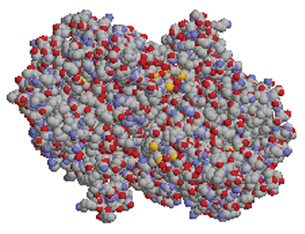
© 2002-2007 Steve Cook
You can observe this reaction first-hand by using hydrogen peroxide from a first-aid kit or purchased from your local pharmacy. You will also require some supplies from your local grocery store or supermarket.
Materials
- pharmaceutical grade hydrogen peroxide (3%)
- beef liver (Chicken liver may be substituted.)
- potato
- glass dish
Procedure
Take a small amount of H2O2—about 5 mL—and add it to a small piece of potato (approximately 1 cm3) in a small test tube or a shallow glass dish. Observe the reaction, and note the products.
Repeat using a 1 cm3 piece of liver. Observe the reaction, and compare it with the previous reaction. Feel the bottom of the test tube or container containing the liver and the H2O2.
Answer the six analysis questions in your Lesson 1 Assignment.
1.8. Page 6
Module 7—The Digestive and Respiratory Systems
 Reflect and Connect
Reflect and Connect
 Self-Check
Self-Check
SC 3. Answer chapter questions 1 to 11 on pages 207 to 215 of the textbook.
 Self-Check Answers
Self-Check Answers
- Carbohydrates, lipids, proteins, and nucleic acids make up the four categories of macromolecules. (answer 1)
- The process that builds macromolecules is dehydration synthesis. (answer 2)
- The process that breaks down macromolecules is hydrolysis. (answer 3)
- Two types of carbohydrates are simple sugars and polysaccharides. Subunits of simple sugars include mono or disaccarides and they are composed of one or two glucose molecules, such as maltose. Polysaccharides contain more than two glucose molecules—an example is cellulose. (answer 4)
- Subunits that make up fats are glycerol and three fatty acid molecules. (answer 5)
- With saturated fats, all fatty acids contain single bonds between carbon atoms. Meanwhile, with unsaturated fats, at least one of the fatty acids in the molecule contains a double covalent bond between two adjacent carbon atoms. (answer 6)
- The subunits that make up proteins are amino acids. (answer 7)
- Proteins are more structurally and functionally diverse than carbohydrates and lipids because of the R-group. Structurally, the combination of attraction and repulsion of different R-groups along a protein will result in a complex, three-dimensional structure. Functionally, since R-groups can be positively or negatively charged, proteins can be water soluble or water insoluble. Proteins such as enzymes are water soluble, while the proteins in your fingernails are insoluble, or they repel water. (answer 8)
- An enzyme is a specific protein molecule in a biological system that increases the rate of a chemical reaction. (answer 9)
- An enzyme lowers the energy required for a substrate molecule to react. By binding to the substrate, the enzyme weakens the bonds within the substrate, allowing it to become more reactive. This speeds up reactions. (answer 10)
- An increase in temperature can increase the rate of enzyme binding to the substrate, allowing for an increase in the rate of reaction. However, if the temperature is too high, the enzyme can be damaged or denatured. This would slow or cease reactions. The pH can affect the shape of proteins. If an enzyme’s shape (particularly the active site) is altered due to pH, the ability of the substrate to bind to this area may be affected, altering the rate of reaction. (answer 11)
 Module 7: Lesson 1 Assignment
Module 7: Lesson 1 Assignment
Remember to submit the Assignment answers to your teacher as part of your Module 7: Lesson 1 Assignment.
1.9. Page 7
Module 7—The Digestive and Respiratory Systems
 Lesson Summary
Lesson Summary
In this lesson the following questions were examined:
- What are the chemical characteristics of carbohydrates, lipids, and proteins and their corresponding enzymes?
- How are digestive enzyme functions controlled by the internal environment?
Carbohydrates, lipids, proteins, and nucleic acids are macromolecules and all have distinct characteristics. Carbohydrates can be simple sugars or polysaccarides. Their purpose is to store energy. Lipids are insoluble in water, store energy, and form the hormones of estrogen and testosterone. Lipids comprise membranes because of their insoluble nature. The bond structure of lipids causes them to be saturated or unsaturated.
Proteins are the most functionally diverse macromolecule. Hair, bones, muscles, nuclei, and nails all contain very different proteins. Proteins are made up of chains of amino acids. An amino group is connected to a carbon molecule, which is bonded to an acid group. There are 20 different amino acids that can bond together in different combinations to give different proteins. The physical structure of proteins determines whether they will be water soluble (enzymes) or insoluble (fingernails).
Enzymes are designed to bind to substrate molecules (which are any macromolecules). Each enzyme has a specifically shaped binding, or activation, site. Enzymes exist to speed up reactions in building or breaking down molecules. If people’s bodies lacked enzymes, they could not quickly access the stored energy of glucose from a polysaccaride chain. As a result, they could die.
Enzymes also require optimal conditions to work. As seen in the virtual lab, there was an optimal pH range at which enzymes were the most productive. In your textbook, “Figure 6.11” on page 215 showed that the optimal temperature for enzyme action was around 37oC or body temperature. If internal conditions become too basic or acidic or too hot or cold, enzyme function can be inhibited. Enzyme function can also be controlled by negative feedback loops.
Lesson Glossary
anabolic: the metabolic process that builds larger molecules from smaller molecules
catabolic: the metabolic process in which materials are broken down
catalyze: to increase the rate of reaction
dehydration synthesis: an enzyme-controlled composition reaction in which compounds are formed by the removal of water
feedback inhibition: the process by which the accumulated end product of a biochemical pathway stops the synthesis of that product
hydrolysis: the decomposition of a compound in a reaction by using water
substrate molecule: a molecule that an enzyme interacts with chemically
For example, the enzyme sucrase only binds to the substrate molecule of sucrose.
1.10. Lesson 2 Intro
Module 7—The Digestive and Respiratory Systems
Lesson 2—The Digestive System
 Get Focused
Get Focused

© Mike Liu/shutterstock
Have you ever eaten so much that you thought your stomach was going to explode? On July 4, 2006, Takeru “The Tsunami” Kobayashi, of Nagano, Japan, set a world record by downing almost 54 hot dogs and buns in 12 minutes at the annual Coney Island Hot Dog Eating Contest.
Kobayashi is a multiple title-holder in the world of competitive eating. He pushes the human body to new limits of the gastrointestinal variety. His daily intake of 6000 calories is three times the recommended amount for an average person. However, he claims his 89-kg, 1.71-m frame carries a mere 10% body fat.
While you might marvel at the seemingly impossible and potentially dangerous eating feats of “The Tsunami,” some relatively simple biological concepts may help to explain his success.
As a competition approaches, Kobayashi eats greater amounts of food. He is expanding his stomach to prepare for the incredible volume of food that will enter his body in a short period of time. He also regularly weight trains and works out—these factors help push his rate of cellular respiration higher and helps him burn the excess calories that he takes in while training. This lessens the likelihood that his food intake will be stored and converted to fat, which would impair the critical expansion of his stomach during competitions.
Finally, perhaps the true secret to his success is that he is reported to have a condition called gastroptosis. This non-fatal disorder allows his stomach to displace downward beneath his rib cage, where it has a lot more room to expand as food fills it up.
There is no doubt that this example of an extreme test of the digestive system is not for everyone. The overall health implications of this kind of consumption would be negative, if not fatal, in most circumstances. This example does, however, raise the obvious question of how exactly the digestive system functions.
In this lesson you will learn about the digestive system's anatomy. You will discover how your body processes the food and drink that you take in on a daily basis. By tracking the pathway of digestion from the ingestion of food through the breakdown of macromolecules to the absorption of nutrients and, ultimately, the excretion of waste, you should gain a better understanding of the interdependence of the body’s various organ systems.
In this lesson the following essential questions will be examined:
- How do the organs of the digestive system work together to digest carbohydrates, lipids, and proteins?
- In what way does the body facilitate the exchange of energy and matter from the digestive system?
 Module 7: Lesson 2 Assignment
Module 7: Lesson 2 Assignment
Your teacher-marked Module 7: Lesson 2 Assignment requires you to submit a response to the following:
Try This: The Journey From Gums to Bums
There are four parts to this assignment.
- TR 1. Mapping the Route from Gums to Bums
- TR 2. Enroute From Gums to Bums
- TR 3. Enroute from Gums to Bums: The Small Intestine and Accessory Organs
- TR 4. Enroute from Gums to Bums: The Large Intestine
You can access your Module 7: Lesson 2 Assignment. You can print off the assignment or save the download to your computer. Your answers can be saved on this document to your course folder.
You must decide what to do with the questions that are not marked by the teacher.
Remember that these questions provide you with the practice and feedback that you need to successfully complete this course. You should respond to all the questions and place those answers in your course folder.
1.11. Page 2
Module 7—The Digestive and Respiratory Systems
 Explore
Explore
Before you begin this lesson, you may find it useful to look over a list of vocabulary and definitions that you will be required to know as you work through this lesson. You can print off or save the following vocabulary chart to your course folder.
The chart is incomplete and requires you to fill in a definition or a corresponding vocabulary word. The chart is long, but you likely are already familiar with some of the words on the list. As you encounter unfamiliar words, refer to this chart to record definitions and words as a tool to help you organize what happens in the digestive system.
Structures of the Digestive System
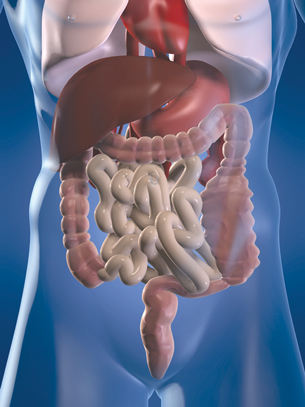
© Sebastian Kaulitzki/shutterstock
How much thought or planning do you put into what you will be eating for breakfast, lunch, and supper? Nutritious meals take a great deal of planning to provide the optimal quantities of nutrients, vitamins, and minerals necessary to keep people’s bodies at the peak of health.
Despite the effort involved in preparing food, there is little conscious thought once the food begins its journey through the gastrointestinal tract. People really only think about two stages—the decision to swallow the masticated bolus (chewed food ball) and the purposeful decision to eliminate the fecal material after processing the food.
Everything in between is part of a complex and automatic response. It ensures that the food taken in ends up being converted to either usable molecules, which are absorbed, or to unusable waste products, which are eliminated.
You can find many animations and videos on the Internet that will show you the path of food through your digestive system. Perform the following two web searches:
- keywords: tv demonstrating biology demonstrations
- keywords: how stuff works digestive system
The first web search could result in a video that explains demonstrations to use in the classroom. The first demonstration in the video may show how you can simulate the path of food through the body.
Perhaps the second animation traces the pathway of food as it passes from the mouth to the anus. Pay particular attention to the structures that make up the pathway and their location. If this information is available, note the discussion of the breakdown of the milk sugar lactose, and check the repercussions of not being able to break down this sugar.
The diagram on page 217 of your text outlines all of the structures of the digestive system.
 Self-Check
Self-Check
SC 1. Do the following Self-Check activity about structures of the digestive system.
1.12. Lab
Module 7—The Digestive and Respiratory Systems
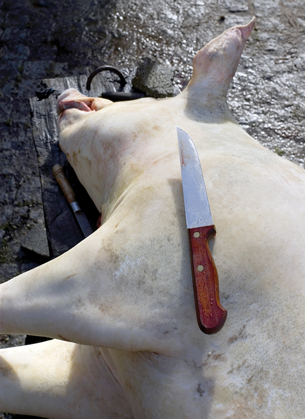
© José Correia Marafona/shutterstock
 Lesson 2 Lab: Virtual Pig Dissection
Lesson 2 Lab: Virtual Pig Dissection
One of the best ways to learn about the structures of any organ system in the human body is to dissect an organism with a similar body plan. You will now go to the online “Virtual Pig Dissection” and explore the “Digestive System of the Virtual Pig.”
To find this virtual dissection, perform a web search using the keywords “virtual pig dissection Whitman.”
Once you have opened the dissection, read the instructions about necessary computer plug-ins. Proceed by clicking on “digestive system” in the “STUDY GUIDES” box. As you go through this part of the dissection, note that you will be viewing two general regions of the body where digestion takes place: the head and the abdominal cavity. You can first choose the head or skip to the abdominal cavity dissection.
Make sure that you follow all of the steps and click on all possible parts of the system indicated in the photos as “Things to Note.” Once you have finished going through the entire dissection of the digestive system, proceed to “QUIZZES” and click on “digestive system.” There are several quizzes there, and you will need to obtain the correct answers to the first quiz before proceeding to the next one. This is a good review of the digestive system structures, functions, and enzyme actions. You may want to take screen captures of the dissection or the quizzes and save them to your course folder for review.
1.13. Page 4
Module 7—The Digestive and Respiratory Systems
Digestion

© Johanna Goodyear/shutterstock
Have you ever chewed gum for so long that it dissolved? Digestion starts with the physical mashing of food in your mouth. As well, each organ that comes into contact with snacks or meals secretes a particular enzyme to catalyze the digestion of specific macromolecules. In the case of chewing gum, eventually the enzymes in your saliva will break down the starches in your gum.
The movement of food through the digestive system is dependent on the smooth muscles of the motor system. Peristalsis and sphincters control the movement of food, or chyme, through your system.
peristalsis: the wavelike series of muscular contractions and relaxations in structures such as the esophagus
sphincter: a ringlike muscular structure that normally maintains constriction of a natural body passage or orifice and that relaxes as required by normal physiological functioning
chyme: the partially digested, semi-fluid mass of food that is forced from the stomach into the small intestine
 Read
Read
Read “Digestion Begins: The Mouth and the Esophagus” on pages 218 and 219 of the textbook.
 Try This
Try This
TR 1. Mapping the Route from Gums to Bums
Begin creating a flow chart or a diagram that states the first two structures involved in digestion—the mouth and esophagus—the function of the structures, as well as the secretions and functions of the secretions. Throughout this lesson, beginning now, there will be several spots where you will return to your Lesson 2 Assignment to add to your digestive Gums to Bums journey.
 Read
Read
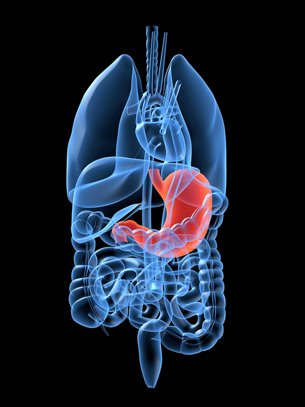
© Sebastian Kaulitzki/shutterstock
Further physical and chemical digestion occurs once food enters the stomach via the esophagus. An empty stomach can look very small, like a sausage. However, it has the capacity to expand to hold a large meal from an all-you-can-eat buffet or, in the case of “The Tsunami,” 54 hot dogs and buns. Read “Storing, Digesting, and Pushing Food: The Stomach” on page 220 of the textbook.
 Self-Check
Self-Check
SC 2. Do the following Self-Check activity about digestion.
1.14. Page 5
Module 7—The Digestive and Respiratory Systems
 Watch and Listen
Watch and Listen
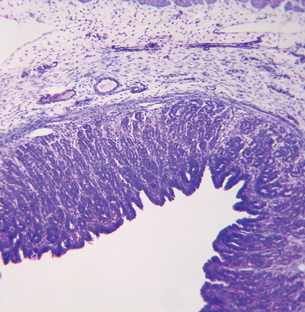
© Jubal Harshaw/shutterstock
Your Stomach Is Not an Island
The control of the digestive process is one that involves an interaction between the nervous system, the endocrine system, the circulatory system, and the digestive system. Watch the following animation Hormones and Gastric Digestion about the regulation of digestion.
Pay particular attention to the positive feedback that reinforces the continued release of gastric secretions into the stomach. In addition, watch for the negative feedback that shuts off the release of these secretions when stomach digestion is complete.
For more information about feedback and homeostasis, check page 203 in the textbook.
pepsinogen: the inactive precursor to pepsin formed in the chief cells of the mucous membrane of the stomach and converted to pepsin by hydrochloric acid during digestion
pepsin: a digestive enzyme found in gastric juice that catalyzes the breakdown of protein to peptides
Hydrochloric acid and pepsinogen are secreted by the stomach as components of gastric juice. These secretions are signaled by nerve impulses and hormones when you taste, smell, touch, or think of food. Once in the stomach, pepsinogen is activated by the low pH levels created by the hydrochloric acid (HCl) and is converted to the active enzyme pepsin. Pepsin catalyzes the breakdown of proteins to smaller units called peptides.
 Try This
Try This
TR 2. Enroute from Gums to Bums
 Read
Read
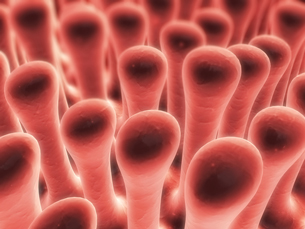
© Sebastian Kaulitzki/shutterstock
Return to the Assignment to add the stomach, its functions, secretions, and the function of its secretions to your flow chart or diagram.
The small intestine is, in fact, much longer than the large intestine but because of its smaller diameter it has been labelled “small.” The small intestine has several structural elements that aid in its main function of completing the digestion of macromolecules and absorption of the subunits.
Several accessory organs provide digestive assistance through their secretions. The pancreas, liver, and gall bladder secrete enzymes that help to complete the digestion of macromolecules. In this way, the resulting subunits can be transported across cell membranes and delivered to the circulatory system for distribution to all body cells.
To help you complete the next Self-Check and Try This, you will need to read “Digesting and Absorbing Nutrients: The Small Intestine” on pages 222 to 228 of the textbook.
The small intestine has the largest role in the digestive system.
 Self-Check
Self-Check
SC 3. Do this Self-Check exercise about the small intestine.
 Try This
Try This
TR 3. Enroute from Gums to Bums: The Small Intestine and Accessory Organs
Go to your Assignment to add the small intestine, its functions, its secretions, and the function of its secretions to your flow chart or diagram. Don’t forget to also include the pancreas, liver, duodenum, and gall bladder.
 Read
Read
The purpose of digestion is to break down macromolecules into useable components for growth and repair. Once digestion has finished, what does the body do next?
As you have come to see, no body system is independent of another. A complex network of circulatory vessels are highly concentrated in the villi of the small intestine.
As molecules become small enough to move across cell membranes, they are actively transported via transport proteins. Molecules, such as amino acids, move across the villi membrane where they then diffuse into the blood for circulatory transport to other body cells.
Glucose, a result of carbohydrate digestion, would be used by cells to generate ATP, which would power active transport. Diagrams on the bottom of pages 226 and 227 of the textbook illustrate the active transport of molecules across the cell membrane.
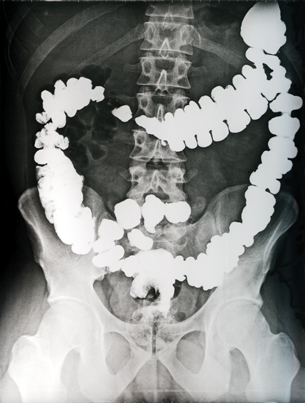
© Danilo Ascione/shutterstock
 Read
Read
The colon is the main portion of the large intestine. Once chyme has entered the large intestine, there is no more digesting to be done. The main function of the intestine is to concentrate wastes and eliminate wastes.
By absorbing water and salts, the large intestine can reduce 500 mL of undigestible chyme to 150 mL of feces to be stored in the rectum and excreted.
Read page 231 of the textbook for a more detailed summary of the function of the large intestine.
 Try This
Try This
TR 4. Enroute from Gums to Bums: The Large Intestine
Go to the Assignment to add the large intestine and its function to your flow chart or diagram.
1.15. Page 6
Module 7—The Digestive and Respiratory Systems
 Reflect and Connect
Reflect and Connect
Can you imagine the journey of 54 hot dogs that were eaten in a few minutes?
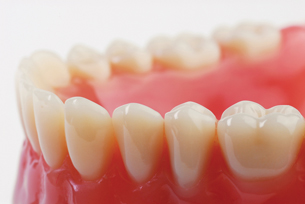
© Steve Simzer/shutterstock
 Self-Check
Self-Check
SC 4. Complete this Reflect and Connect Self-Check activity.
 Reflect on the Big Picture
Reflect on the Big Picture
Now that you know more about the details of digestion, build upon the analogy that your body is like a bank. Creating analogies can be a useful way of connecting something you don’t think about very often (digestion) to something you may use every day (the bank). Save your analogy to your course folder.
 Going Beyond
Going Beyond
As you have seen in Lesson 2, diet plays an important role in keeping people’s bodies in homeostasis. With such a wide range of foods and supplements available, it is easy to become confused about meeting proper nutritional needs.
This is where a trained registered dietitian (RD) can be very useful because an RD can provide information to you about food choices. RDs also assist in the development and promotion of consumer products as well as helping to manage food services in health institutions. A dietitian can be important to individuals even if they’re not elite athletes who push their bodies to extremes.
As an example, Kelly Anne Erdman is a registered dietitian for the Canadian Sport Centre in Calgary, the National Coaching Institute, and the University of Calgary Sport Medicine Centre. She was a member of the Canadian cycling team from 1985 to 1992 and was on the 1992 Canadian Olympic team as a cyclist.
Kelly Anne completed her Master of Science in Kinesiology Degree at the University of Calgary in 2004 while investigating dietary supplement usage and patterns among high-performance athletes. She provides nutritional information to top-level athletes in the hope that they will be at their peaks on competition day. The food and supplements that an athlete consumes can mean the split-second difference between a gold medal and last place.
Research the duties of a registered dietitian by searching for “Alberta Learning Information Services” on a web search.
Determine the answers to these questions.
- Investigate the difference between a nutritionist and a dietitian.
- Indicate where a dietitian may work.
- Find out what requirements are needed to become a professionally qualified dietitian in Canada.
 Module 7: Lesson 2 Assignment
Module 7: Lesson 2 Assignment
Remember to submit the Assignment answers to your teacher as part of your Module 7: Lesson 2 Assignment.
1.16. Page 7
Module 7—The Digestive and Respiratory Systems
 Lesson Summary
Lesson Summary
In this lesson you explored the following questions:
- How do the organs of the digestive system work together to digest carbohydrates, lipids, and proteins?
- In what way does the body facilitate exchange of energy and matter from the digestive system?
This lesson focused on the major structures of the digestive system and how the structures process the food and fluids that people ingest. You have charted the process of digestion from gums to bums.
Digestion first begins in the mouth. An enzyme specific to starch digestion is secreted in your saliva, and chewing begins physical digestion. Once in the stomach, hydrochloric acid and pepsin begin the breakdown of protein. This is what you will vomit if you are ill.
The small intestine is where the majority of digestion and absorption of nutrients occur. The six metres of intestine uses enzyme secretions from the gall bladder, liver, and pancreas to complete the digestion of fats, proteins, and carbs.
Billions of fingerlike projections, called villi, line the small intestine and increase the surface area for nutrient absorption to the bloodstream. Molecules are actively transported from the small intestine to be dissolved into the bloodstream.
Mitochondrion depend on the digestion of carbohydrates to fuel ATP synthesis. The remaining undigested material moves to the large intestine (colon) where minerals, vitamins, salts, and water are reabsorbed. The remaining feces is stored in the rectum, thus concluding the journey from gums to bums.
Lesson Glossary
chyme: the partially digested, semi-fluid mass of food that is forced from the stomach into the small intestine
pepsin: a digestive enzyme found in gastric juice that catalyzes the breakdown of protein to peptides
pepsinogen: the inactive precursor to pepsin formed in the chief cells of the mucous membrane of the stomach and converted to pepsin by hydrochloric acid during digestion
peristalsis: the wavelike series of muscular contractions and relaxations in structures such as the esophagus
sphincter: a ringlike muscular structure that normally maintains constriction of a natural body passage or orifice and that relaxes as required by normal physiological functioning
1.17. Lesson 3 Intro
Module 7—The Digestive and Respiratory Systems
Lesson 3—The Respiratory System
 Get Focused
Get Focused
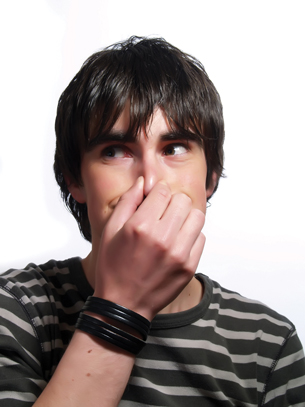
© Henri Schmit/shutterstock
Have you ever tried to see how long you can hold your breath? How long did you last? 30 seconds? 45 seconds? It is not possible for a healthy person to hold his or her breath indefinitely. The buildup of carbon dioxide in your blood triggers a strong hunger for oxygen. Involuntary control takes over, your body reboots, and breathing resumes.
Breathing is one of the few physiological processes that occurs reflexively but can still be controlled consciously. Conscious attention to breathing is common in many forms of meditation like yoga. In swimming, cardio fitness, speech, and vocal training, you learn to control your breathing for purposes other than life support.
Since you don’t control the overall process of breathing, how exactly does oxygen from the atmosphere enter your body? How do your lungs fill up with carbon dioxide to exhale?
In this lesson you will explore the following essential question:
- How do the principal structures of the respiratory system act to exchange matter and transfer thermal energy between the body and the external environment?
 Module 7: Lesson 3 Assignment
Module 7: Lesson 3 Assignment
Your teacher-marked Module 7: Lesson 3 Assignment requires you to submit a response to the following:
- TR 2. The Mechanics of Breathing
- TR 3. Complete Investigation 7A OR Interpreting a Spirograph
You can access your Module 7: Lesson 3 Assignment. You can print off the assignment or save the download to your computer. Your answers can be saved on this document to your course folder.
You must decide what to do with the questions that are not marked by the teacher.
Remember that these questions provide you with the practice and feedback that you need to successfully complete this course. You should respond to all the questions and place those answers in your course folder.
1.18. Page 2
Module 7—The Digestive and Respiratory Systems
 Explore
Explore
The Structure and Function of the Respiratory System

The main function of the respiratory system is to ensure that oxygen is brought to each cell in the body and that carbon dioxide leaves each cell and is removed from the body. Respiration is the general term that is used to describe this overall process.
With every breath you take, an invisible mixture of dust, fungi, bacteria, water, nitrogen, oxygen, carbon dioxide, and argon enters your respiratory tract. These substances are on a journey that will trap some of them in the cilia of the lung, sweep out others with your breath, and ultimately allow only one substance—oxygen—to pass into the bloodstream.
Oxygen from the atmosphere passes over warm, moist membranes in the nose and mouth known as the upper respiratory tract. Oxygen enters an ever-branching, ever-narrowing hair-lined network of passageways from the trachea to the bronchial branches.
Finally, oxygen reaches the more than a quarter-of-a-billion blind, grape-like sacs at the passageway’s end that is the alveoli in the lung. It is here that oxygen enters the circulatory system in exchange for carbon dioxide. The carbon dioxide then makes the reverse journey out of the body.
The next diagram shows the basic structure and function of the respiratory system. The Canadian Lung Association’s web page will help you get a better understanding of the labelled structures and has information on the process of respiration. By the end of this lesson, you should be able to give a clear and concise explanation of what each part of the respiratory system does.
To help you with the vocabulary associated with this lesson and as a support, a vocabulary review sheet is available to be downloaded.
 Try This
Try This
In Lesson 2 you conducted a virtual dissection of a pig’s digestion system. In this lesson you will use the same virtual dissection site to explore the pig’s respiratory system.
You may want to read pages 244 to 247 of your textbook before you perform a virtual pig dissection.
TR 1. Virtual Pig Dissection
When you are ready to begin the virtual lab, go to the online “Virtual Pig Dissection” and explore the “Respiratory System of the Virtual Pig.”
To find this virtual dissection, you will have to perform a web search using the keywords “virtual pig dissection Whitman.”
Once you have opened the dissection, read the instructions about necessary computer plug-ins. Proceed by clicking on “respiratory system” in the “STUDY GUIDES” box. Make sure that you follow all of the steps and click on all possible parts of the system indicated in the photos as “Things to Note.”
Once you have finished going through the entire dissection of the respiratory system, proceed to “QUIZZES” and click on “respiratory system.” There are several quizzes there, but in order to proceed to the next quiz you must obtain the correct answers. This is a good review of the respiratory system structures and functions. You may want to take screen captures of the dissection or the quizzes and save them to your course folder for review.
 Watch and Listen
Watch and Listen
Watch the following animation that shows the voyage of a molecule of oxygen through the structures that make up the respiratory passageways and the subsequent return of carbon dioxide to the atmosphere.
 Self-Check
Self-Check
SC 1. Answer this Self-Check exercise that has questions related to breathing.

© Sebastian Kaulitzki/shutterstock
There are two stages to breathing—inspiration and expiration. These are better known as breathing in and out. This movement of air into and out of the lungs is controlled by muscles that change the size of the pleural cavity (the thin, fluid-filled space between the two membranes that surround the lungs). This change in pleural cavity size affects pressure in the cavity relative to the external atmospheric pressure. Air naturally moves from a higher pressure to a lower pressure.
During inhalation, the pressure is greater in the atmosphere than it is in the pleural cavity because the size of the pleural cavity is increased, thereby decreasing its pressure.
 Read
Read
When exhalation occurs, the pressure in the pleural cavity is increased by decreasing its size. Read pages 249 and 250 in the textbook for more information.
 Self-Check
Self-Check
SC 2. Complete this Self-Check exercise.
 Try This
Try This
TR 2. The Mechanics of Breathing
The diaphragm and the rib muscles (internal and external intercostals) control the air pressure inside the lungs that causes air to move in and out of the lungs.
Go to your Lesson 3 Assignment where you will be asked to illustrate the processes of inhalation and exhalation.
1.19. Page 3
Module 7—The Digestive and Respiratory Systems
Gas Exchange
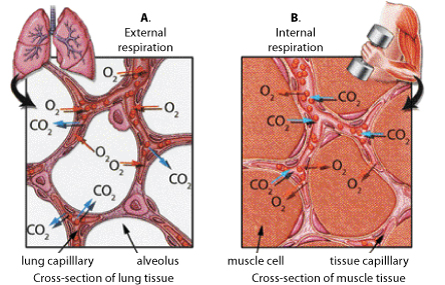
Inquiry into Biology (Whitby, ON: McGraw-Hill Ryerson, 2007), 252, fig. 7.7. Reproduced by permission.
Gas exchange occurs as a result of a difference in the partial pressures of oxygen and carbon dioxide in different body regions.
External respiration occurs at the lungs. Oxygen concentration (or partial pressure) is higher in the alveoli than it is in the blood of capillaries that surround the alveoli. As a result, oxygen moves from the alveoli to the blood. Conversely, carbon dioxide moves from blood to the alveoli because its partial pressure is higher in blood.
 Read
Read
Internal respiration involves the exchange of gases at the body tissue’s cells. The concentrations of oxygen in the blood are higher than they are in the tissue’s cells. Carbon dioxide concentrations are higher in the cells than they are in the blood. Consequently, gas exchange follows the normal patterns of diffusion—movement is from a higher concentration to a region of lower concentration. If you feel you need to further clarify this concept, read “Gas Exchange and External Respiration” starting on page 250 of the textbook.
 Watch and Listen
Watch and Listen
Watch the animation Gas Exchange that shows both external and internal respiration. Notice how the gases move from higher partial pressures to lower partial pressures. Click on the link, and then start the animation by clicking on the “Play” button. Once you have finished watching, answer the five review questions that follow.
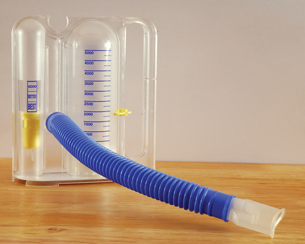
© Glenda M. Powers/shutterstock
 Try This
Try This
TR 3. Investigation 7.A or Interpreting a Spirograph
Spirometers are given to people who have undergone heart or lung surgery. Doctors use incentive spirometers to encourage patients to regain lung capacity after surgery.
If you have access to a spirometer, try “Investigation 7.A: Measuring Respiratory Volumes” on page 251 of the textbook.
If you are unable to complete Investigation 7.A, you can complete “Interpreting a Spirograph.”
Go to your Lesson 3 Assignment to complete either Investigation 7.A or Interpreting a Spirograph.
Respiratory System Provides Protection
Up to this point, the obvious priority of the respiratory system was the exchange of gases. But have you considered that another role of the respiratory system is to defend against foreign matter and heat transfer?
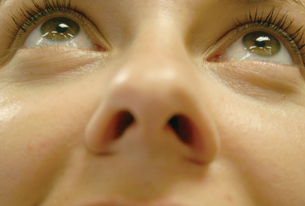
Consider the analogy of a fort that provides strong protection. Soldiers in the fort fight off enemies that try to enter. Parts of the respiratory tract are like soldiers. They fight to protect people from germs, dust, and pollen in the air. Where are these body “soldiers”? How do they work? The first “line-of-defence” is found in the nose.
The inside of the nose is lined with small hairs and a sticky liquid called mucus.
- The hairs filter out dust and pollen.
- The mucus traps germs (usually bacteria) as well as dust and pollen.
cilia: small, hairlike organs on the surface of some cells, particularly cells lining the upper respiratory tract
Their wavelike movements waft particles of dust and debris outward; Latin for “eyelash.”
The nose cannot keep out all harmful substances. Some substances get past the nose and enter the windpipe. Sometimes harmful substances enter the windpipe from the mouth as well. So the windpipe must continue the fight. The windpipe, like the nose, is lined with mucus. It is also lined with very tiny (microscopic) hairs called cilia. Cilia are always beating in an outward direction, like a broom that keeps sweeping toward a door leading outside. A single hair is called a cilium.
- The mucus traps many harmful substances.
- The cilia sweep harmful substances outward.

Courtesy of the U.S. National Library of Medicine/National Institutes of Health
Coughing and sneezing also help because they build strong gusts of air. This forces out many harmful items from the respiratory tract. Sometimes the body soldiers fail in their jobs and people become ill. Then people must take proper care of themselves in order to be healthy again.
Breathing also serves to dissipate heat created by cellular respiration. This is one of your body’s methods of maintaining a 37°C core temperature. If you breathe on the back of your hand, you will feel that your breath is warmer.
To illustrate this point, you will look at the chain of reactions that occur when you begin exercising. You increase the use of your muscles. They start requiring more oxygen in order to oxidize more glucose to fuel ATP production. In the meantime, carbon-dioxide production is increased.
Breathing increases to try and maintain homeostasis. As ATP is used, or metabolized, heat is released from broken phosphate bonds. Heat is transferred from cells via the circulatory system to the alveoli. Some heat dissipates into the lungs and is transferred to the external environment as a method to maintain homeostasis.
1.20. Page 4
Module 7—The Digestive and Respiratory Systems
 Reflect and Connect
Reflect and Connect
 Self-Check
Self-Check
SC 3. Complete the following Reflect and Connect Self-Check exercise.
You may also want to work on questions from your textbook. If you would like feedback on any questions in your textbook, contact your teacher.
 Discussion
Discussion
Negative feedback mechanisms control breathing rates. Changes in carbon dioxide and/or oxygen concentrations in the blood drive these mechanisms. The first stimulus that triggers an increase in the breathing rate is high carbon-dioxide levels. Does it surprise you that it isn’t low oxygen concentrations?
chemoreceptor: detects chemical stimuli in the environment and turns stimuli into electrical nerve impulses that signal parts of the body to respond accordingly
Chemical receptors found in the medulla oblongata of the brain trigger a message. These chemoreceptors signal the diaphragm and intercostal muscles of the rib cage. The message is “increase breathing movements.” The result is a greater exhalation of carbon dioxide. This gives a lowered blood CO2 concentration—a negative feedback response.
Oxygen chemoreceptors are found in the aorta and carotid arteries. These chemoreceptors respond to low oxygen levels even if carbon-dioxide levels in the blood are normal. For example, this might occur at high altitudes. The negative feedback response would again be controlled by the medulla oblongata, which would again stimulate an increase in breathing movements. Blood-oxygen levels would increase.
Create a diagram that illustrates the negative feedback involved in the process of breathing. Do you have the right idea? Post your diagram in the discussion area. See what other students have posted. Do you need to make any modifications, or did you get it right the first time around?
 Reflect on the Big Picture
Reflect on the Big Picture
Can you add to your analogy of your body being a bank now that you know more about the respiratory system?
1.21. Page 5
Module 7—The Digestive and Respiratory Systems
 Lesson Summary
Lesson Summary
In this lesson you explored the following question:
- How do the principal structures of the respiratory system act to exchange matter and transfer thermal energy between the body and the external environment?
The respiratory system is a sophisticated exchange system. From your nose to the alveoli in your lungs, energy and matter exchange occur. An inhalation may contain foreign objects. These objects, such as dust, pollen, or germs, are filtered out by cilia and mucus that line the respiratory tract from the nose to the bronchioles. By the time inhaled air reaches the alveoli, the only substance present and ready to diffuse into the bloodstream is oxygen.
Alveoli, or air sacs, also collect carbon dioxide that diffuses from the bloodstream. Carbon dioxide moves from millions of alveoli through the bronchioles, to the bronchi, trachea, and finally to the nose or mouth in every exhalation. You were able to see these structures through various animations and a virtual dissection. The mechanics of breathing are controlled by air pressure and the need to get rid of carbon dioxide. As cellular respiration proceeds, carbon dioxide builds up.
Your body has chemoreceptors that are sensitive to changes in carbon dioxide levels. Nerve messages are relayed to the brain and then back to the muscle that controls breathing—the diaphragm. In a relaxed shape, the diaphragm is curved up toward the lungs.
As the diaphragm contracts, space or volume increases in the chest cavity. This decreases the pressure inside the chest cavity and makes the internal pressure lower than the air pressure in the external environment. In order to restore equilibrium, air moves from areas of high pressure to low pressure. As a result, you inhale.
As you inhale, the pressure within the chest cavity increases so that it becomes greater than the external air pressure. In order to restore equilibrium, air moves from areas of high pressure to low pressure. As a result, you exhale. Your diaphragm has also been signaled to relax by higher levels of carbon dioxide.
You also learned that there are several parts to your breath as determined by a spirograph. Breathing is a continuous process that is cyclic. You can control how you breathe, but you cannot control if you breathe.
Your respiratory system also plays another role in maintaining equilibrium through energy exchange. As heat is produced in cellular respiration, it is transported by the circulatory system. Heat dissipates into the lungs and is transferred to the external environment with each exhalation.
While this lesson looked primarily at the respiratory system as an individual body system, it should be noted that there are many other systems involved in ensuring that the respiratory system works to maintain homeostasis.
Lesson Glossary
chemoreceptor: detects chemical stimuli in the environment and turns stimuli into electrical nerve impulses that signal parts of the body to respond accordingly
cilia: small, hairlike organs on the surface of some cells, particularly cells lining the upper respiratory tract
Their wavelike movements waft particles of dust and debris outward; Latin for “eyelash.”
1.22. Lesson 4 Intro
Module 7—The Digestive and Respiratory Systems
Lesson 4—Science, Technology, and Society
 Get Focused
Get Focused

© aceshot1/shutterstock
You have probably experienced illnesses that have affected your respiratory or digestive system. Most people have experienced the common cold. In some cases, it may develop into bronchitis, which is an infection in your bronchioles that results in a bad cough and wheezy breathing.
Some people may make themselves sick by smoking, consuming too much alcohol, or having a poor diet. Whether illness is caused by lifestyle choices, genetics, or germs, there are ways to treat disorders so that homeostasis can be maintained by the body. Not all disorders can be fixed by technology alone.
In this lesson you will explore the following essential question:
- How does technology provide solutions or limitations to the treatment of disorders affecting the digestive and respiratory systems?
 Module 7: Lesson 4 Assignment
Module 7: Lesson 4 Assignment
Your teacher-marked Module 7: Lesson 4 Assignment requires you to submit a response to the following:
- TR 1. Health and the Digestive System: Traditional vs. Western Practices
- TR 2. You Diagnose It
You can access your Module 7: Lesson 4 Assignment. You can print off the assignment or save the download to your computer. Your answers can be saved on this document to your course folder.
You must decide what to do with the questions that are not marked by the teacher.
Remember that these questions provide you with the practice and feedback that you need to successfully complete this course. You should respond to all the questions and place those answers in your course folder.
1.23. Page 2
Module 7—The Digestive and Respiratory Systems
 Explore
Explore
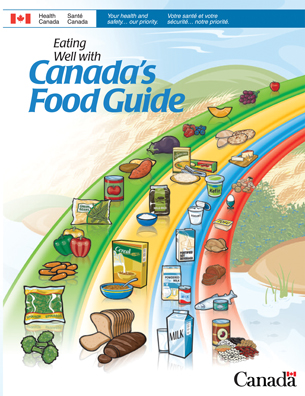
© Her Majesty the Queen in Right of Canada
Health and the Digestive System
There is a strong relationship between your overall health and the nutritional decisions you make in life. Proper and balanced nutrition is the only way to provide your body with the energy to perform activities such as muscle contraction, cell growth, and cell repair. Since the end result of digestion is the absorption of nutrients, salts, and water, most disorders of the digestive system affect either the nutritional state of the body or its salt and water content. A healthy diet and lifestyle can prevent some disorders with medical technology diagnosing and treating the more serious disorders.
Ulcers, inflammatory bowel disease, hepatitis, cirrhosis, and gallstones are some disorders that directly affect the organs of the digestive system. Anorexia, bulimia, and obesity are digestion-related conditions arising from psychological, social, and cultural conditions. While medicine and technology can treat some of these diseases, they cannot alter how people choose to treat their bodies.
 Read
Read
Turn to pages 233 to 236 of your textbook to explore these disorders. Read these pages before completing the following activity.
 Try This
Try This
TR 1. Health and the Digestive System: Traditional vs. Western Practices
Read the following paragraphs:
First Nations, Métis, and Inuit people share a definition of health similar to the World Health Organization, a division of the United Nations. The WHO’s definition says that health is a state of complete physical, mental, and social well-being and not merely the absence of disease. First Nations people traditionally believe that individual health depends not only on a person's individual resources, but can best be assured through the maintenance of healthy social, economic, and cultural systems. With this belief, intervention is necessary with an individual who becomes sick.
According to healers of the Dene Nation, the individual has to take responsibility for his or her own healing. Too often, they believe, people give others the responsibility to take care of their minds, their bodies, their emotions, and their spirituality in a disconnected way.
Many First Nations people believe in practising traditional medicine. Traditional medicine refers to health practices, approaches, knowledge, and beliefs incorporating plant, animal, and mineral-based medicines, spiritual therapies, manual techniques, and exercises. These practices are used alone or in combination to diagnose, treat, and prevent illnesses, or maintain well-being.
Many Albertans support the Western medical system, where medical doctors and other health-care professionals (such as nurses, pharmacists, and therapists) treat symptoms and diseases using drugs, medical treatments, or surgery.
Choose one of the digestive disorders mentioned in your textbook or one that you may be familiar with from your research or personal knowledge. How would a First Nations healer approach dealing with the disorder compared to a doctor practising Western medicine?
Go to your Lesson 4 Assignment to complete this activity and to see the marking guide.
1.24. Page 3
Module 7—The Digestive and Respiratory Systems
Respiratory Health
emphysema: an obstructive respiratory disorder in which the walls of alveoli break down and lose elasticity
There are fewer individual air sacs as walls break down, thus reducing the surface area for gas exchange. A loss of elasticity makes exhaling more difficult.
There are diseases specifically associated with the respiratory system. You can have a lower respiratory tract disorder (bronchi, lungs, alveoli) or an upper respiratory tract disorder (nose, pharynx). Some of the diseases are a result of lifestyle choices, such as most cases of emphysema, commonly referred to as smoker’s disease, while other diseases are the result of tumours, bacteria, viruses, or genetics. Medical advances have made it possible to cure some of these diseases. Some diseases, such as emphysema, are incurable but it is possible to treat the symptoms.
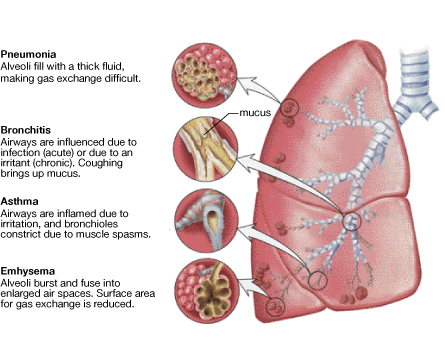
Inquiry into Biology (Whitby, ON: McGraw-Hill Ryerson, 2007), 257, fig. 7.8. Reproduced by permission.
 Read
Read
As you read through pages 256 to 261 of the textbook, create a table of common respiratory disorders that lists the symptoms, the cause of the symptoms, how the disorder interferes with breathing, and how each disorder would be diagnosed. You will be using this chart in the next Try This activity.
 Try This
Try This
TR 2. You Diagnose It
Complete “Thought Lab 7.2” on page 261 of the textbook. In this activity you will look at the symptoms of two patients and determine what their disorder may be. You will use your chart of respiratory disorders to aid in making your diagnosis.
Go to your Lesson 4 Assignment to complete this activity.
 Self-Check
Self-Check
SC 1. What is the connection between healthy dietary practices and a healthy functioning body?
SC 2. Pancreatitis is an inflammation of the pancreas. It occurs when digestive enzymes attack and destroy the pancreas and nearby tissues and cause pain and scarring. Why would a person with pancreatitis have difficulty digesting carbohydrates, lipids, and proteins?
SC 3. Why would restrictive surgery, such as stomach stapling, help an obese person lose weight?
SC 4. Why does pneumonia affect a person’s ability to breathe properly?
SC 5. How does lung cancer interfere with gas exchange?
 Self-Check Answers
Self-Check Answers
SC 1. Good nutrition is the only way to provide the energy people need to carry out their many activities, such as nerve transmission, muscle contraction, and cell repair and replacement. As well, good nutrition provides the essential raw materials that bodies need as building blocks but are unable to manufacture themselves.
SC 2. A person with pancreatitis would have difficulty digesting carbohydrates, proteins, and lipids in the small intestine because
-
a lack of trypsin and chymotrypsin would reduce protein digestion
-
a lack of pancreatic amylase would reduce starch digestion
-
a lack of lipase would reduce fat digestion
SC 3. Given that the stomach acts as a reservoir for food during ingestion, restrictive surgery would limit the amount of food that a person could ingest during a meal. With less food entering the digestive tract, caloric intake would be reduced and result in weight loss.
SC 4. Pneumonia is a disease that occurs when the alveoli in the lungs inflame and fill with liquids. This interferes with gas exchange, and the body becomes oxygen-starved.
SC 5. Lung cancer diminishes gas exchange because tumours destroy healthy areas of the lung. This reduces the surface area for gas exchange. Alveoli can be damaged and allow fluids, such as blood, to fill up air sacs and reduce gas exchange.
1.25. Page 4
Module 7—The Digestive and Respiratory Systems
 Reflect and Connect
Reflect and Connect
What made you feel better when you were sick? Was it the medicine, good food, or rest? Sometimes medicine can’t fix everything that makes people ill—there are limits to how far medical technology can go in making people healthy 100% of the time.
Sometimes you have to change your lifestyle in order to feel healthier. Someone diagnosed with emphysema will have to quite smoking. Another person with cirrhosis may have to stop drinking alcohol.
 Discuss
Discuss
Answer one of the following questions:
Do you think that traditional remedies have value? Does part of your health-care regime include aspects of traditional medicine? If so, why? If not, would you consider it? Create a response to these questions, and post them in the discussion area. Read other responses. Are they similar to yours? Why would some responses be different?
OR
What responsibility should health care and research have for diseases caused by lifestyle choices? Create a response to this question, and post it in the discussion area. Read other responses. Are they similar to yours? Why would some responses be different?
 Reflect on the Big Picture
Reflect on the Big Picture
What does a respiratory or digestive disorder do to create havoc with your body’s ”banking” system? Complete your bank analogy by discussing disorders compared to a healthy system.
 Module 7: Lesson 4 Assignment
Module 7: Lesson 4 Assignment
Remember to submit the Assignment answers to your teacher as part of your Module 7: Lesson 4 Assignment.
1.26. Page 5
Module 7—The Digestive and Respiratory Systems
 Lesson Summary
Lesson Summary
In this lesson you explored the following essential question:
-
How does technology provide solutions or limitations to the treatment of disorders affecting the digestive and respiratory systems?
As you looked at disorders of the digestive and respiratory systems, you looked at related symptoms, causes, treatments, and diagnostic technology. You also explored the world views of First Nations, Metis, and Inuit (FNMI) people in regards to traditional medicine.
Traditional medicine incorporates the use of herbal and spiritual remedies to cure illness. It is the belief of both the World Health Organization and FNMI people that health is not just the absence of disease, but health is also mental and social well-being. In contrast, Western medicine often approaches health with the treatment of disease by drugs, invasive medical treatments, and surgery.
By investigating a variety of diseases, you have become familiar with how disorders will interrupt the body’s natural exchange of matter and flow of energy. Both traditional and Western medicines attempt to restore homeostatic balance to your body system.
However, medicine cannot cure all diseases. For example, emphysema is a disease (usually caused from smoking) that is incurable. Being healthy is a function of smart lifestyle choices and available technology that can help you maintain or restore homeostasis.
Lesson Glossary
emphysema: an obstructive respiratory disorder in which the walls of alveoli break down and lose elasticity
There are fewer individual air sacs as walls break down, thus reducing the surface area for gas exchange. A loss of elasticity makes exhaling more difficult.
1.27. Module Summary/Assessment
Module 7—The Digestive and Respiratory Systems
 Module Summary
Module Summary
In this module you studied the digestive and respiratory systems. In the first lesson you explored the molecules of living systems: proteins, fats, and carbohydrates. Each molecule has specific characteristics that make them unique. Your body uses these nutrients and enzymes to sustain life.
These macromolecules are made up of smaller, chemically simpler subunits. Macromolecules are assembled by dehydration synthesis and are disassembled by hydrolysis. These reactions either add or remove a molecule of water. Each macromolecule has a corresponding enzyme that speeds up chemical reactions such as hydrolysis. Enzymes are designed to have an active site for a specific molecule, or substrate, on its surface.
The substrate will bind to the active site on the enzyme. Bonds in the substrate become less stable and are thus easier to break. This speeds up the process of breaking down substrates or creating new compounds. Enzymes work best under optimal conditions. Factors such as fluctuations in temperature or pH can affect the shape of an enzyme and, therefore, its ability to bind with a substrate molecule.
Inhibitor compounds can also bind to the active site of an enzyme to prevent substrate molecules from binding. A knowledge of these molecules was necessary for you to understand how the digestive system worked together from gums to bums to digest macromolecules. Lesson 2 explored each organ involved in digestion from the mouth to the colon. You also explored how the body exchanges matter and energy via the digestive system. Nutrient absorption, occurring primarily in the small intestine, provides cells with the necessary resources to maintain and repair cellular function. For example, mitochondrion depend on the digestion of carbohydrates to fuel ATP synthesis.
The respiratory system was introduced in Lesson 3. As with all body systems, there is energy and matter exchange occurring via the respiratory system. Primarily, your respiratory system serves to exchange carbon dioxide and oxygen. Oxygen is required for aerobic respiration, and carbon dioxide is a product of aerobic respiration. The act of respiration involving your lungs continuously exchanges oxygen and carbon dioxide in the alveoli.
Breathing is regulated by the need to remove carbon dioxide from your body. Chemoreceptors sense a buildup of carbon dioxide and stimulate the diaphragm to relax. This causes you to breathe out. The air pressure inside your lungs when the diaphragm is relaxed is higher than external air pressure. In order to maintain equilibrium, air will move from high pressure to low pressure. When you breathe in, the diaphragm is contracted to create more volume and less pressure inside your chest cavity. In an effort to maintain pressure equilibrium, you will inhale.
You looked at the pattern of respiration through interpreting a spirograph. By measuring the volumes of inhalation and exhalation, you can determine levels of fitness or help to diagnose several health conditions. The respiratory system is also a mechanism for body temperature control. Heat produced by cellular respiration is dissipated into the lungs and transferred to the external environment with each inhalation. Conversely, cold air is warmed along its journey to the alveoli in an effort to maintain body equilibrium.
In Lesson 4 you learned about the effects of lifestyle choice, germs, and genetics on the health of your digestive and respiratory system and about how technology may limit or benefit the treatment of any disorders. You were asked to compare traditional and Western medicine practices.
Traditional medicine incorporates the use of herbal and spiritual remedies to cure illness. In contrast, Western medicine often approaches the treatment of disease by drugs, invasive medical treatments, and surgery. By investigating a variety of diseases you discovered how disorders interrupt the body’s natural exchange of matter and flow of energy. Both traditional and Western medicines attempt to restore homeostatic balance to your body system. However, medicine cannot cure all diseases. Being healthy is a function of smart lifestyle choices and available technology that can help you maintain or restore homeostasis.
This module has allowed you to investigate two important systems. Each system—digestive and respiratory—plays an important role in maintaining homeostasis. In the final module of this course, you will explore the circulatory, immune, and excretory systems.
Module Assessment
Now that you have completed the lessons in this module, you will complete a module project. In the module project you will have the choice between two extended responses.
Module Project
The purpose of an extended response is to help you take a closer look at a specific area of study. In this case you will choose between investigating digestive enzymes through experimentation OR investigating the effects of smoking on the respiratory system.
You may choose one assignment because you feel you have a stronger grasp of the content, or you may choose an assignment because you feel you would benefit from further study of that particular body system. The extended response activities allow you to further explore each body system. In the Unit Assessment you will build upon these module projects by pursuing an in-depth inquiry into the interdependence of your body systems in maintaining homeostasis.
Choice 1. The Digestive System: Investigating Digestive Enzymes
In this investigation you will look at the materials a student has used to show that a pancreatic enzyme hydrolyzes fats into glycerol and fatty acids. Based on your knowledge of enzyme action, you will be asked to recreate the experiment that the student may have performed, based on the given materials, and predict results. You may wish to recreate this lab virtually, if required.
Use the following information to answer the next question.
Investigating Digestive Enzymes
A student performed an activity to show that lipase, an enzyme produced in the pancreas, does hydrolyze fats into glycerol and fatty acids. The student was provided with the following materials:
Materials
-
whole milk (cereal cream)
-
lipase solution
-
3, 25-mL test tubes
-
phenolphthalein (Phenolphthalein is a pH indicator that is pink in a base and colourless in an acid.)
-
dish soap
-
10% sodium bicarbonate solution (NaHCO3)
-
3 rubber stoppers
-
medicine droppers
-
test tube holder
- wax pencil
- 37°C hot water bath
- Design an experiment demonstrating that lipase digests milk to produce an acid and that emulsification is important in the digestion of lipids. Write the steps of a procedure. Be sure to include a control test in the procedure. (10 marks)
- Explain the purpose of the milk, the soap, the sodium bicarbonate, and the water bath in this investigation. (4 marks)
- Use a data chart to predict what the student observed in each test tube during the investigation, and interpret the results in each test tube. (6 marks)
- Identify the test tube that would show the fastest reaction, and explain why. (2 marks)
Choice 2. The Respiratory System
In this activity you will look at a technology doctors use to diagnose respiratory disorders. You will also examine the effects of smoking on the respiratory system.
Use the following information to answer the next question.
Bronchoscopy
Bronchoscopy is a surgical technique for viewing the interior of the airways, using sophisticated flexible fibre-optic instruments. The procedure involves inserting a tube with a tiny camera on the end through the nose or mouth into the respiratory tract.
- If the flexible fibre-optic instrument was inserted through the nose, list, in order, the parts of the respiratory system that the camera would pass. (8 marks)
- A doctor suspects her patient may have lung cancer. What is lung cancer? Identify one reason why a doctor would order a bronchoscopy for this patient. (3 marks)
To answer questions 3, 4, and 5, look up the following terms on the Internet: "cough reflex," "smoker's cough," and "emphysema."
- Describe how smoking interferes with the body’s ability to maintain gas exchange between internal and external environments. Explain how a smoker’s cough is the body’s attempt to maintain balance. (4 marks)
- Identify the three symptoms that a person with emphysema would have, and explain why these symptoms would occur. (6 marks)
- Most people with emphysema are or were smokers. Explain the role that smoking plays in developing this disorder. (3 marks)
1.28. Module Glossary
Module 7—The Digestive and Respiratory Systems
Module Glossary
anabolic: the metabolic process that builds larger molecules from smaller molecules
catabolic: the metabolic process in which materials are broken down
catalyze: to increase the rate of reaction
chemoreceptor: detects chemical stimuli in the environment and turns stimuli into electrical nerve impulses that signal parts of the body to respond accordingly
chyme: the partially digested, semi-fluid mass of food that is forced from the stomach into the small intestine
cilia: small, hairlike organs on the surface of some cells, particularly cells lining the upper respiratory tract
Their wavelike movements waft particles of dust and debris outward; Latin for “eyelash.”
dehydration synthesis: an enzyme-controlled composition reaction in which compounds are formed by the removal of water
emphysema: an obstructive respiratory disorder in which the walls of alveoli break down and lose elasticity
There are fewer individual air sacs as walls break down, thus reducing the surface area for gas exchange. A loss of elasticity makes exhaling more difficult.
feedback inhibition: the process by which the accumulated end product of a biochemical pathway stops the synthesis of that product
hydrolysis: the decomposition of a compound in a reaction by using water
pepsin: a digestive enzyme found in gastric juice that catalyzes the breakdown of protein to peptides
pepsinogen: the inactive precursor to pepsin formed in the chief cells of the mucous membrane of the stomach and converted to pepsin by hydrochloric acid during digestion
peristalsis: the wavelike series of muscular contractions and relaxations in structures such as the esophagus
sphincter: a ringlike muscular structure that normally maintains constriction of a natural body passage or orifice and that relaxes as required by normal physiological functioning
substrate molecule: a molecule that an enzyme interacts with chemically
For example, the enzyme sucrase only binds to the substrate molecule of sucrose.